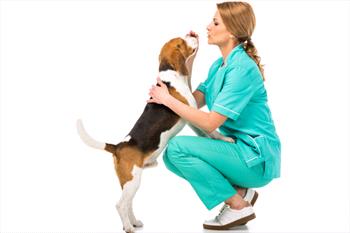Veterinarian talking to dog

Photo courtesy of Depositphotos
When I was a newer graduate, I shadowed an older colleague as he saw his appointments that day. He walked into the exam room and had a brief conversation with the owner before checking his patient in for a procedure. He was curmudgeonly, a little stern, all business. When he was finished, he picked up the little dog with one arm, shoved the file under the other, and walked to the treatment area, placing the dog on the examination table.
As soon as he put the dog on the table, his whole face and body language changed. “Who's my good boy? Who's my good boy!?” he asked as the dog wagged his tail excitedly and licked the veterinarian's face.
It was like night and day.
We all talk to our animals. It's probably human nature. After all, we also tend to have conversations with our babies.
“Is your diaper wet?”
“Aaaa-yah”
“Well then, I think we need to go take care of that. What do you think? Do you want a dry diaper?”
“Ahh-eee”
“Of course, you do. Let's go.”
In fact, studies show that these “conversations” with babies where we talk-listen-talk just like we do with our spouses (you do listen to your spouse, right?) help their brains develop. Parents are encouraged to have these nonsensical discussions with our non-verbal mini-me's. So, it's really not a surprise that we talk to our pets as well.
In fact, veterinarians talk to your pets, too. It wasn't just my gruff colleague doing it. A recent study about the "Doolittle factor" looked at these conversations between vet and pet. It came up with 12 different types of dialogue veterinarians have with their patients. They ranged from admonishment (“There's no need to growl”) to empathy (“Oh you poor thing! That looks like it hurts”) to soliciting cooperation (“Can you stand up for me?”).
What was interesting to me was that the amount of conversation in general and the specific types of conversation differed depending on which side of the pond you were in. In the U.S. the top three types of talk were praise (“What a good boy!”), small talk (“You're such a handsome guy”), and explanation (“I just need to open your mouth for a second”). Veterinarians in the U.K. also had praise and explanation in their top three, but calming (“That's it, just a little bit more”), empathy, and small talk all tied for third.
Also, the Americans were chattier. They talk to their patients almost twice as often as those in the U.K. I'm not sure what that says about Americans.
What does this mean for you and your pet? Likely nothing terribly important. But maybe when I tell you that my Dr. Jekyll-and-Mr. Hyde colleague was great with pets but not so much with humans, you'll believe me. And if you don't believe me, ask your dog.